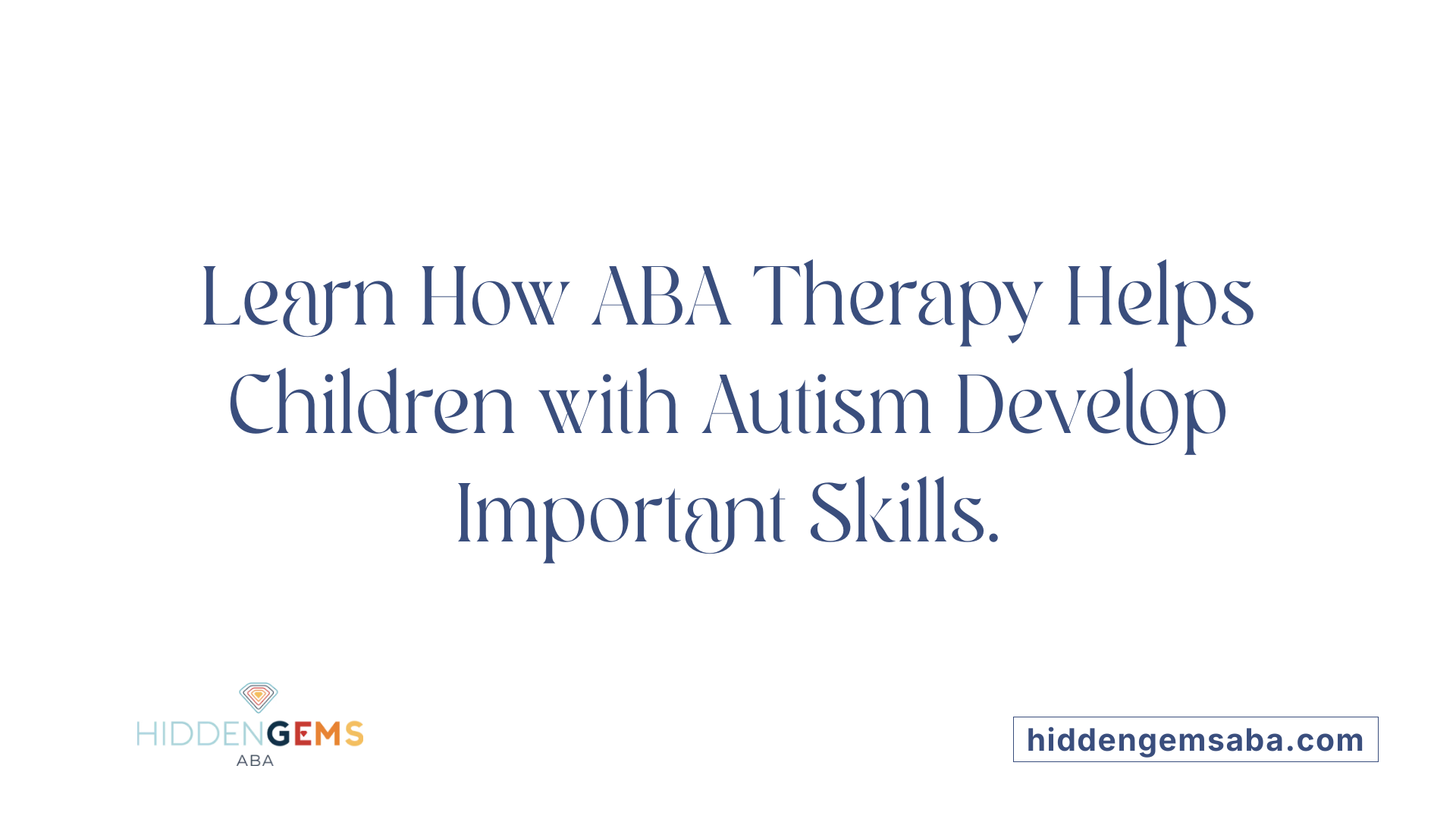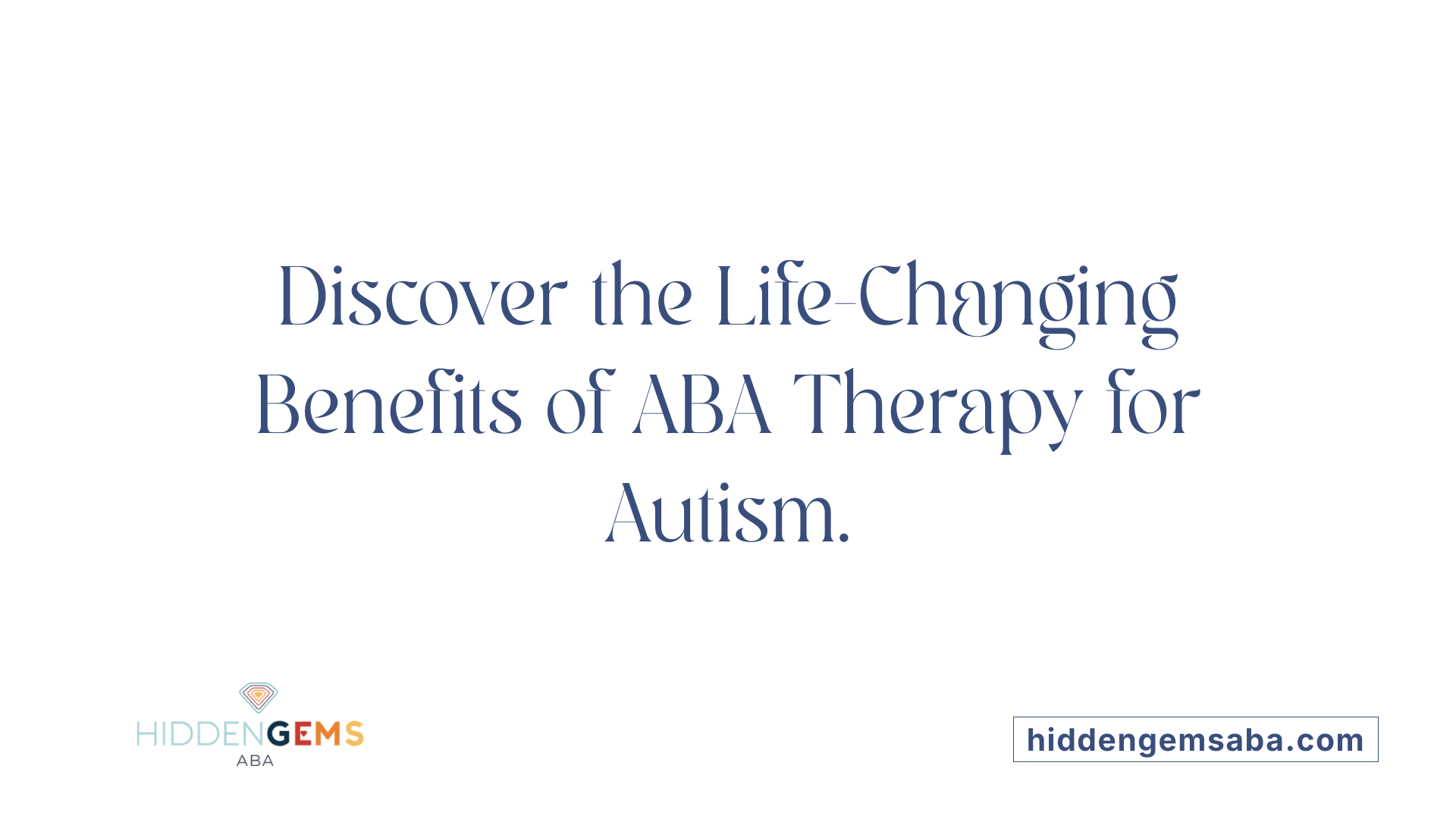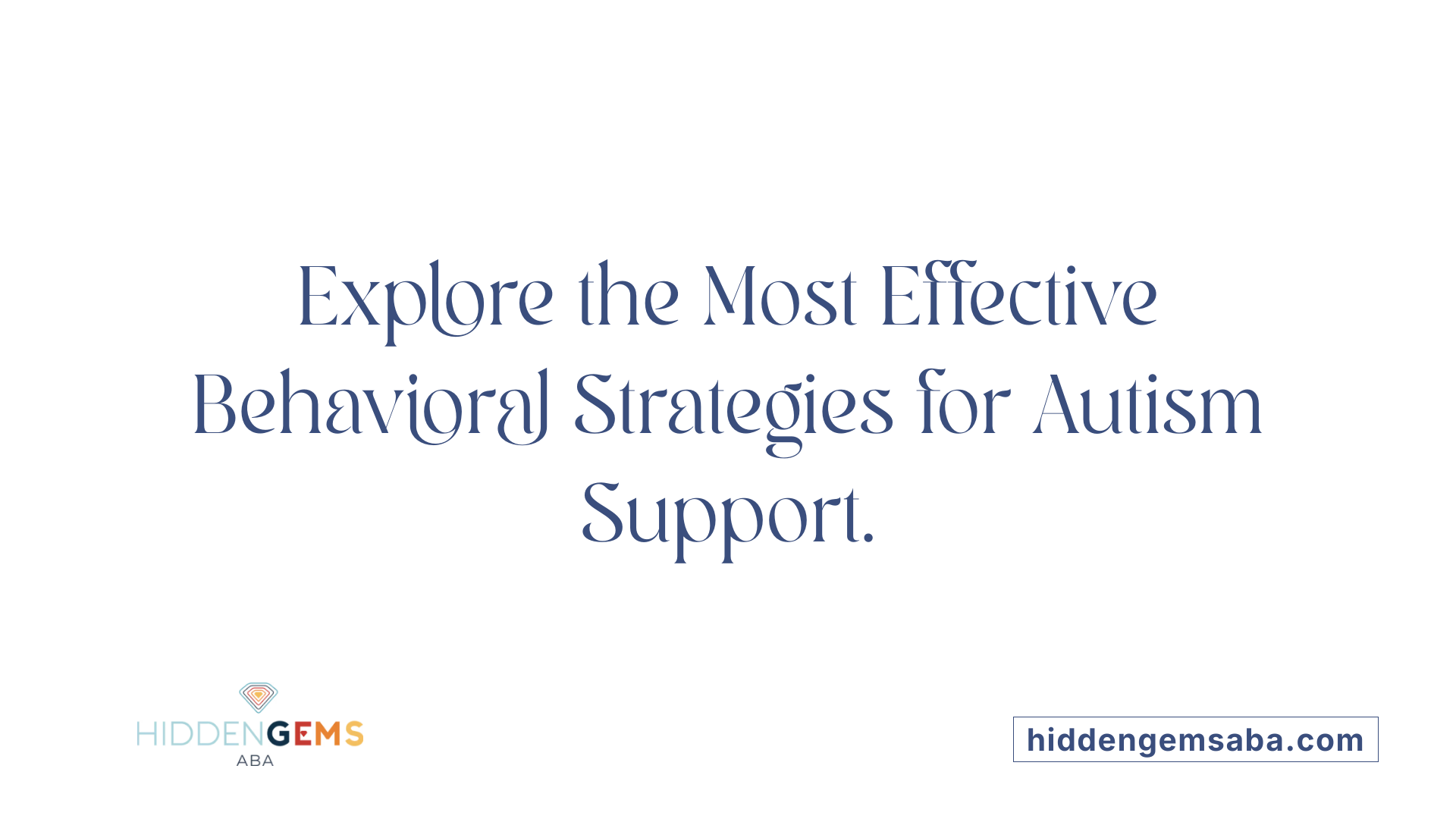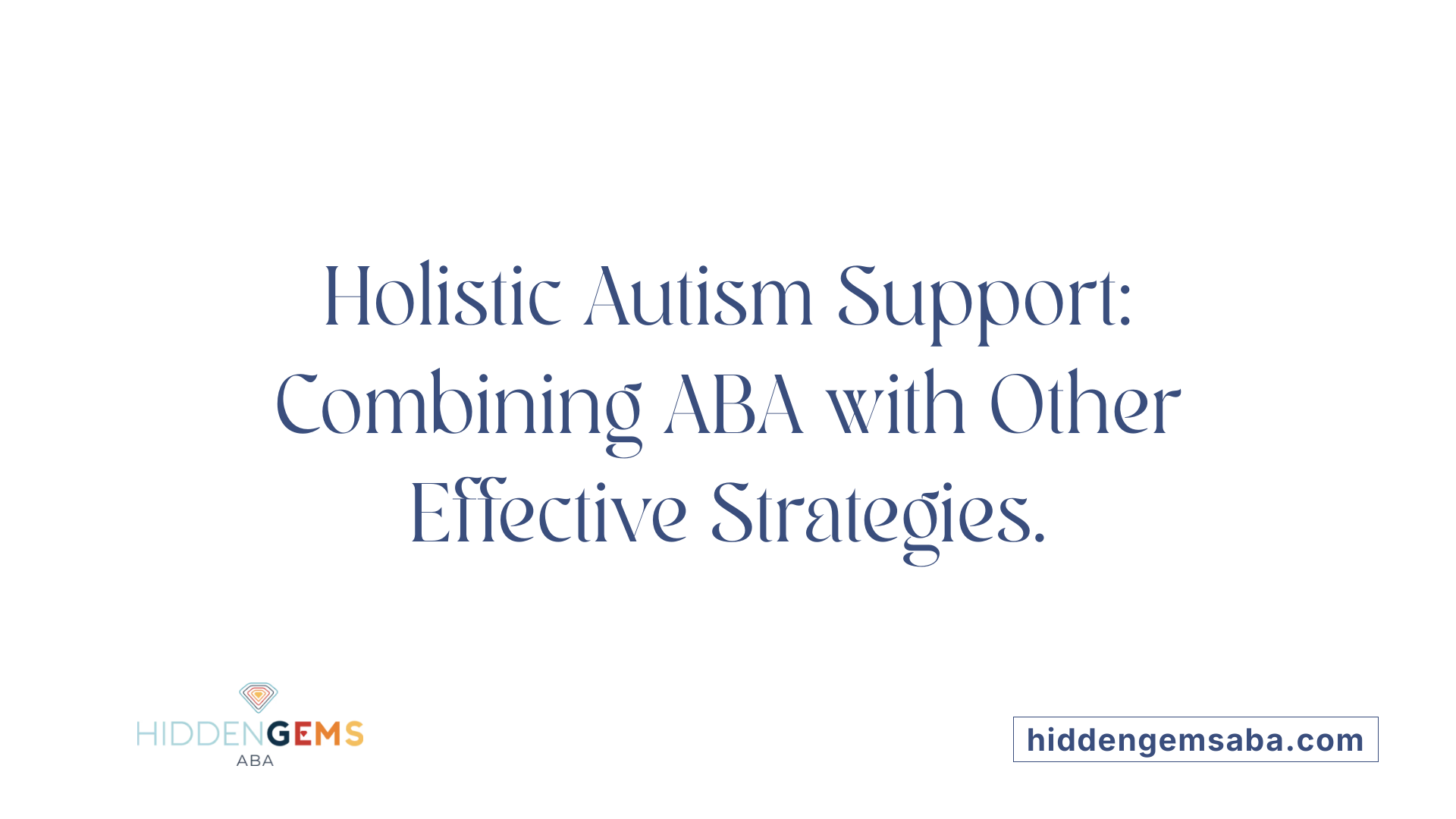Understanding ABA Therapy for Autism Spectrum Disorder
Applied Behavior Analysis (ABA) is a scientifically validated, evidence-based therapeutic approach that has transformed autism support. Recognized globally and endorsed by major health organizations, ABA works by understanding how behavior functions and how learning occurs. This comprehensive overview explores what ABA entails, its benefits, the various methods employed, and how families can access these services through insurance and Medicaid, empowering children and their caregivers with knowledge and hope.
What Is ABA Therapy for Autism and How Does It Work?

What is ABA therapy for autism and how does it work?
ABA therapy, or Applied Behavior Analysis, is a scientifically supported approach used to help children with autism develop essential skills and reduce problematic behaviors. It is based on the science of learning and behavior, which means understanding how behaviors are influenced by the environment.
ABA works by breaking down complex skills into small, manageable steps. Therapists then teach these steps through structured activities, rewarding desired responses with positive reinforcement. This reinforcement encourages children to repeat helpful behaviors and gradually learn new skills.
The foundational concept of ABA involves analyzing the ABCs—Antecedent, Behavior, and Consequence. Antecedents are triggers or cues that lead to a behavior, and consequences are what follow that influence whether the behavior increases or decreases. By modifying antecedents or consequences, therapists can help shape more appropriate behaviors.
Every ABA program is tailored specifically to each child's needs. A Board Certified Behavior Analyst (BCBA) assesses the individual and develops a personalized treatment plan with specific goals. These goals may include improving communication, social skills, daily living skills, or decreasing harmful behaviors.
Various techniques are employed within ABA, including Discrete Trial Training (DTT), Pivotal Response Treatment (PRT), and the Early Start Denver Model (ESDM). DTT involves short, structured teaching sessions with clear prompts and rewards, while PRT is play-based and encourages pivotal skills like motivation and initiation of communication in natural settings. ESDM combines play and traditional ABA methods to target multiple developmental areas simultaneously.
ABA therapy can be administered in several environments, such as at home, in school, or within community settings, making it a flexible option for many families. The therapy is typically intensive at the start—often around 10-20 hours per week—and adapts over time based on progress.
Research consistently shows that early and sustained ABA intervention can lead to significant improvements. These include better language skills, enhanced social interactions, greater independence, and reductions in problem behaviors. As a recognized, evidence-based treatment endorsed by organizations like the US Surgeon General, ABA remains one of the most effective approaches for improving life quality for children with autism.
Overall, ABA’s goal is to support children in participating meaningfully in society and to foster joyful, autonomous living by helping them build essential skills and reduce barriers to social engagement.
Benefits of ABA Therapy for Children with Autism

What are the benefits of ABA therapy for children with autism?
Applied Behavior Analysis (ABA) therapy provides a range of important benefits for children diagnosed with autism spectrum disorder (ASD). The therapy is rooted in scientific research and focuses on encouraging positive behaviors while reducing harmful or disruptive behaviors.
One of the most well-documented benefits of ABA is the improvement in social skills. Children learn to initiate and engage in social interactions more effectively, which can help them develop friendships and participate more fully in community activities. Alongside social gains, communication skills—both verbal and non-verbal—are often significantly enhanced through the consistent use of reinforcement techniques and targeted interventions.
Language development is another critical area positively impacted by ABA. Children working with ABA therapists often make notable progress in expressing their needs and understanding others, which is vital for their overall independence and integration into society.
Designing individualized treatment plans enables ABA to address specific daily living activities. Children can learn essential self-care skills such as dressing, eating, and personal hygiene. These improvements foster increased independence and confidence in managing everyday tasks.
ABA also plays a crucial role in reducing problematic behaviors. For example, self-injury, tantrums, or aggressive actions are often diminished through carefully implemented strategies incorporating reinforcement and environmental adjustments. By decreasing these behaviors, children can better concentrate on learning new skills and engaging with others.
The long-term impact of early and intensive ABA therapy is profound. Research indicates that children who receive therapy during their early developmental years—before age four—often experience large gains in cognitive, language, and social domains. This early intervention can potentially lessen the need for future specialized services and help children achieve greater independence.
Moreover, ABA is adaptable across multiple settings, including home, school, and community environments. Therapists, families, and educators collaborate to reinforce skills consistently, creating a comprehensive support system.
Overall, ABA not only targets immediate behavioral improvements but also contributes to long-lasting developmental growth. For many children, this results in improved quality of life, increased participation in society, and a better outcome in pursuing their personal goals and dreams.
| Benefit Area | Improvements Achieved | Additional Notes |
|---|---|---|
| Social Skills | Better peer interactions, initiating play and conversation | Tailored strategies for social engagement |
| Communication & Language | Increased vocabulary, better understanding, expressive language | Speech and alternative communication methods support |
| Daily Living Skills | Self-care, dressing, eating, toileting | Promotes independence in everyday activities |
| Reduction of Harmful Behaviors | Less self-injury, tantrums, aggression | Reinforcement and environmental adjustments |
| Developmental Outcomes | Cognitive gains, language skills, adaptive behavior | Early, intensive therapy yields larger improvements |
Impact of early and intensive intervention
Beginning ABA therapy early in life, particularly before age four, and committing to more than twenty hours per week can produce substantial developmental gains. These include improvements in intellectual functioning, language abilities, and social interaction skills. The early use of ABA has also been associated with a decreased need for later intensive services, directly benefiting the child's long-term independence and societal participation.
In overlaying these benefits, ABA therapy aims to equip children with autism with the tools needed to manage their behaviors effectively, communicate their needs, and participate actively in their communities. The personalized and scientifically grounded nature of ABA ensures that each child's unique needs are addressed, fostering an environment conducive to joyful and autonomous living.
Behavioral Therapy Approaches in Autism Support

What types of behavioral therapy approaches are used for autism?
When it comes to supporting children with autism, various behavioral therapy methods are employed to encourage positive development and reduce challenging behaviors. Among these, applied behavior analysis (ABA) stands out as the most widely recognized and scientifically supported approach.
ABA encompasses several specific techniques tailored to each child's needs. These include Discrete Trial Training (DTT), Pivotal Response Training (PRT), Early Intensive Behavioral Intervention (EIBI), and the Early Start Denver Model (ESDM). Understanding these methods provides insight into how behavioral therapy addresses autism.
Discrete Trial Training (DTT) involves structured, sequential teaching sessions. During DTT, therapists give clear, simple instructions or prompts for a particular skill. When the child responds correctly, they receive a reward, such as praise or a small toy, reinforcing the behavior. This technique breaks down complex tasks into manageable steps, making learning systematic and measurable.
Pivotal Response Training (PRT) is a play-based, less structured form of ABA. It focuses on pivotal skills—such as motivation, self-initiation, and social reactions—that can lead to improvements in other areas. PRT uses the child's interests and choices to naturally motivate learning, promoting spontaneous communication and social interactions in familiar settings.
Early Intensive Behavioral Intervention (EIBI) offers an intensive, individualized approach for young children, typically under age 6. EIBI combines principles of ABA with a focus on early development, providing many hours of tailored therapy each week. Research indicates that EIBI can lead to significant gains in language, cognitive skills, and independence.
Early Start Denver Model (ESDM) integrates play-based activities with ABA techniques, targeting multiple developmental areas such as social interaction, language, and cognitive skills. ESDM emphasizes natural play contexts, making learning engaging and relevant for the child.
Besides these, other approaches like Positive Behavioral Support (PBS) focus on modifying the environment to make desired behaviors more likely, while reducing problematic behaviors. The overarching goal of these methods is to enhance communication, foster social skills, and promote independence.
By customizing these techniques, therapists can create effective programs that are sensitive to each child's strengths and challenges, supporting meaningful progress in various aspects of life.
| Technique | Description | Focus Areas | Typical Setting |
|---|---|---|---|
| DTT | Structured, step-by-step teaching with rewards | Skill acquisition, compliance | One-on-one sessions, clinical or home |
| PRT | Play-based, uses child's interests | Motivation, communication | Natural environments, home, school |
| EIBI | Intensive, early intervention | Language, cognition, independence | Clinical settings, home |
| ESDM | Play and developmental-focused integration | Social, communication, cognitive | Home, therapy centers |
These approaches are combined with ongoing assessments, family involvement, and data collection to ensure tailored, effective therapy plans tailored to each child's unique needs.
Appropriateness of ABA Therapy and Candidate Selection

When is ABA therapy appropriate or not appropriate for a child with autism?
ABA (Applied Behavior Analysis) therapy is widely recognized as an effective treatment for children with autism spectrum disorder (ASD), particularly when started early. It is generally most suitable for children between the ages of 2 and 6 years, an age range when foundational skills in communication, social interaction, and daily living are most receptive to development.
During this optimal window, ABA can help foster critical skills that support independence and social participation. The therapy involves intensive, personalized programs designed to improve specific behaviors using proven techniques like positive reinforcement and structured instruction.
However, the decision to initiate or continue ABA depends on individual circumstances. If a child has achieved significant progress, with minimal disruptive behaviors and demonstrated consistency across different settings, ongoing therapy might be adjusted or phased out. Therapists and caregivers should conduct regular assessments to determine if goals have been met and if the child is progressing toward independence.
In cases where a child's behaviors are uncontrollable or if there is no observable improvement despite sustained efforts, it might be appropriate to reassess the intervention plan. Additionally, as children grow older, especially into adolescence and adulthood, the suitability of traditional ABA may diminish as other supports and therapies become more appropriate.
Ongoing assessment and collaboration among specialists, family members, and the child guide whether to maintain, modify, or discontinue ABA. Therapy duration can vary widely, from a few months to several years, tailored to the child's evolving needs, severity of symptoms, and family goals. When discontinuing ABA, it is recommended to do so gradually, ensuring the child's skills and behaviors are stable, and continued caregiver support is essential.
In some instances, ABA might be less suitable, particularly if interventions are not aligned with the child's developmental maturity, emotional well-being, or if the child's progress permanently plateaus. Furthermore, in adulthood, different therapeutic approaches focusing on skills adaptive to adult life may replace or supplement ABA.
Overall, ABA remains appropriate when used thoughtfully, with clear goals, ongoing evaluation, and in conjunction with other supportive therapies, ensuring the child's best developmental outcomes.
Accessing ABA Therapy Through Insurance and Medicaid

How can families access ABA therapy through insurance or Medicaid?
Navigating the process to access ABA therapy depends on verifying coverage, working with healthcare providers, and understanding the requirements for different plans. Families should begin by confirming whether their insurance plan or Medicaid (such as Medi-Cal in California) covers ABA services. This step includes reviewing policy details and ensuring the therapy is deemed medically necessary.
To qualify for ABA under Medicaid, especially in states like California, children under age 21 with a diagnosis of autism spectrum disorder (ASD) or other developmental disabilities can receive coverage. This process often involves a comprehensive evaluation conducted by a Centers of Excellence (COE) provider—a recognized healthcare professional like a neurologist, psychiatrist, or psychologist for adults over 21.
Once diagnosed, families must obtain a treatment plan or order for ABA therapy, usually prepared by a qualified provider. For children, the evaluation and order must come from a COE, which ensures the diagnosis and treatment plan meet state and Medicaid requirements. The COE helps guide families through the process, including assessments, treatment planning, and pre-authorization.
Families with private insurance plans—whether purchased through Covered California or employer-sponsored—are required by law to have their ABA therapy approved when medically necessary. It is crucial to secure pre-authorization from the insurance company before starting therapy. This step guarantees coverage and can prevent significant out-of-pocket expenses.
Providers within an insurance network typically have arrangements with the insurer, which simplifies billing and ensures coverage for services. It’s advisable for families to verify whether the chosen ABA provider is in-network, as this can significantly reduce costs.
For children with dual coverage—private insurance and Medicaid—the primary payer is usually private insurance. Medicaid may then serve as a supplementary payer, covering remaining costs. This coordination ensures families face fewer financial barriers.
In cases where accessing services faces delays or issues, families are encouraged to work with regional centers or case managers. These organizations assist with evaluations, provider connections, and financial support, especially in publicly funded programs.
Additionally, families can collaborate with school districts through an Individual Education Program (IEP), which may include related services like speech or behavioral supports, aligning with ABA goals.
In summary, accessing ABA therapy involves verifying insurance coverage, obtaining necessary evaluations and documentation from qualified professionals, and working with providers who are approved and in-network. Proper pre-authorization and understanding plan specifics help ensure smooth access to high-quality services for children and adults alike.
Current Practices, Evidence, and Future Directions in ABA Therapy

What are some evidence-based insights and current practices in ABA therapy?
Applied Behavior Analysis (ABA) has a strong foundation of scientific research supporting its effectiveness in treating autism spectrum disorder (ASD) and other developmental conditions. Evidence shows that intensive, long-term ABA can significantly improve cognitive functions, language skills, social interaction, and reduce problematic behaviors. Studies demonstrate notable gains in adaptive behavior, communication, and social skills, especially when therapy begins early—before age four—and involves scheduled sessions of 20 hours per week or more.
Modern ABA emphasizes personalized treatment approaches, where board-certified behavior analysts (BCBAs) tailor interventions based on thorough assessments of individual needs. These assessments help identify strengths and areas for growth, guiding the development of targeted goals. Treatment techniques include discrete trial training (DTT), pivotal response training (PRT), natural environment teaching, and innovative models like the Early Start Denver Model (ESDM). Each approach incorporates positive reinforcement, prompting, and structured learning, adapted for each child.
The therapy is delivered in various environments—home, school, community settings—to promote generalization and real-world application. Ongoing data collection is central, allowing practitioners to monitor progress precisely and modify strategies promptly. This systematic tracking ensures that treatment remains aligned with the child's evolving needs, maximizing developmental gains.
Inclusion of preferences and values of clients and their families is increasingly recognized as crucial. Respecting individual differences and cultural considerations helps improve therapy acceptability and engagement. This person-centered approach enhances the effectiveness of interventions and supports meaningful participation within family and community contexts.
While ABA is well-established, the field is continuously adapting. Recent trends include integrating technology, emphasizing less repetitive, more play-based strategies, and focusing on fostering joy, autonomy, and well-being alongside skill development. The movement towards neurodiversity acknowledges that ABA should not aim to erase core aspects of a person’s identity but rather support their unique qualities and life satisfaction.
Despite the robust evidence base, there is a recognized research gap. Many studies focus on skill acquisition and behavior reduction but lack comprehensive measures of quality of life (QoL). Future research aims to include broader outcome metrics, evaluate the long-term social and emotional impacts of ABA, and compare its effectiveness with alternative and complementary interventions.
In summary, current ABA practices integrate science, clinical expertise, and client preferences. They focus on individualized, data-driven, and holistic approaches, continually evolving to better serve the diverse needs of individuals with autism.
Comprehensive Support Strategies and Multidisciplinary Approach

What other autism support strategies complement ABA therapy?
In addition to Applied Behavior Analysis (ABA), several other therapies and programs play a vital role in supporting children with autism spectrum disorder (ASD). These strategies work alongside ABA to create a comprehensive support system tailored to each child's unique needs.
Speech-language therapy is a crucial component, focusing on improving both verbal and non-verbal communication skills. Therapists may incorporate alternative communication methods, such as picture symbols or assistive technology, to help children express their needs and thoughts more effectively.
Occupational therapy supports the development of essential daily living skills, motor coordination, and sensory processing. It helps children manage sensory sensitivities, enhance fine motor skills, and develop independence in activities like dressing, eating, and self-care.
Several specialized programs are also highly beneficial. TEACCH® (Treatment and Education of Autistic and Communication-related handicapped Children) uses visual cues, Structured Teaching, and individualized plans to foster independence and learning. It emphasizes visual schedules, organized environments, and predictable routines tailored specifically to each person.
DIR® (Floortime) focuses on emotional and relational development. This approach prioritizes building meaningful social connections through play and interaction, aiming to deepen emotional understanding and improve social skills in a naturalistic setting.
PECS® (Picture Exchange Communication System) is another technique that uses picture symbols to facilitate communication, especially helpful for non-verbal children. Over time, this method can also aid in developing verbal language skills.
Integrating these approaches with ABA therapy can offer a holistic support framework. They address various developmental areas, including communication, social interaction, sensory processing, and emotional well-being.
Family involvement and community support are essential elements for long-term success. Training parents and caregivers in these strategies ensures consistency across settings and promotes generalization of skills learned during therapy.
Community programs and social groups provide opportunities for children to practice skills in real-world settings, enhancing their social integration and community participation. This comprehensive approach encourages not only skill development but also confidence, autonomy, and emotional resilience.
The synergy of ABA with complementary therapies ensures a well-rounded support system that adapts to each child's evolving needs, fostering meaningful progress and improved quality of life.
Empowering Families and Supporting Progress
In summary, ABA therapy plays a vital role in autism support by fostering skill development, reducing harmful behaviors, and promoting independence. Its scientific foundation and proven effectiveness make it a fundamental component of comprehensive autism treatment plans. When combined with other therapies and supported by appropriate access pathways through insurance and Medicaid, ABA can significantly improve quality of life for children with autism and their families. Early intervention, personalized approaches, and ongoing progress monitoring are key to maximizing outcomes. As the field continues to evolve, embracing new research and inclusive practices ensures that all individuals receive respectful, effective, and empowering support to thrive in their communities.
References
- Applied Behavior Analysis (ABA) | Autism Speaks
- Applied Behavior Analysis (ABA) therapy | Washington State Health ...
- Treatment and Intervention for Autism Spectrum Disorder - CDC
- Applied Behavior Analysis (ABA) - Cleveland Clinic
- The Controversy Around ABA - Child Mind Institute
- Applied Behavior Analysis in Children and Youth with Autism ...
- Supports and Services | The Autism Project
- How Can ABA Therapy Help a Child With Autism? | UTBS





